FAQs
Carpets
What do I need to do before the fitting date?
Ideally rooms need to be clear of all furniture,(although we can quote for this if required and all furniture needs to be empty so we can move it). Pictures or any other items off the wall. Clear access to the area to be fitted. The old flooring uplifted and the room swept or hoovered ready to receive your new flooring. (again we can quote for uplift and disposal of your old flooring if required). Any decoration and paintwork should have had sufficient time to dry and harden off properly.
Can you uplift and dispose of my existing flooring?
Can you move furniture?
Yes we can but we do need an amount of space to work in so we can fit the flooring. All items of furniture need to be empty so that they are easier to lift and less chance of damage.
If you require this service then please let us know well before the installation date so we can allow enough time to do this and let you know what the cost of this will be.
Can you move white goods?
Yes we can give you a quote for moving white goods although they will need to be disconnected by and re connected by yourselves. We do not disconnect or re connect appliances.
We may not be physically able to move some larger items. eg Large American style fridges etc
Can you move TV's and Computers etc?
No. Sorry, we do not move TV’s or computers. We will not disconnect or re connect these items. This will need to be done by yourselves.
Should I buy new underlay?
Our honest opinion is that a basic carpet will feel fantastic on a new underlay whereas a high quality carpet will not feel much better than the old carpet if it is fitted on old underlay.
When you are buying a new carpet you want it to feel like a new carpet and the underlay makes such a difference for the cost involved. New underlay is recommended for any new carpet installation by the manufacturers of the carpet to give the best comfort and performance and prolong the carpets life and maintain the wear guarantee. Most good quality underlays should have a 10 year life but areas of heavy wear will probably need changing before this.
Reusing existing underlay in these areas will cause the carpet to flatten more quickly, cause premature wear and invalidate any wear guarantee.
My floor is uneven - Do I need Plywood or Smoothing compound?
If the sub-floor is uneven whether it is floorboards or concrete it may need to be smoothed out with plywood or a smoothing compound. This will help to stop the sub-floor showing through the carpet or vinyl flooring. When measuring for flooring we cannot always tell if the sub-floor is smooth and even. Particularly if there is a floor covering already there. Even if we look underneath in one area we cannot know what the entire floor is like until the existing flooring is removed. Uneven floorboards are one of the most common that we come across but sometimes it can be old stone fireplaces or large holes in the floor that have been previously covered. Generally on wooden floors we would recommend overlaying the sub-floor with a 6mm plywood. On most floors this will be good enough but in some cases where the sub-floor is very uneven it may mean you will need a joiner or builder to repair or replace the sub-floor. A suitable flexible smoothing compound can be applied to the plywood if there are still some undulations but these will only take out differences of 3-4mm. The sub-floor needs to be as flat as possible before anything else is applied.
Most concrete floors can have a smoothing compound applied to them to make it a smooth base for floorcoverings. They cannot and do not make a floor flat and level if the existing sub-floor is not flat and level. They can only follow the existing sub-floors levels. If a floor is particularly bad we sometimes have to apply more than one layer of smoothing compound. We generally only quote for one layer as in most domestic areas with a relatively flat sound floor this should be enough. Extra layers of smoothing compound will be chargeable if they are required.
Decoration Marks from installation and getting the flooring to the area required?
As flooring has to be ordered larger than the floor area and trimmed by hand it will come into contact with walls and skirting boards. Carpet backings can be very abrasive and it is the backing that will come into contact with walls or skirting boards etc. As careful as the fitters try to be, it is possible that walls etc. may get scuffed or marked. New paintwork and wallpaper is especially vulnerable and should be allowed to fully dry. A minimum of two weeks is recommended.
Chalk based and matt paints are very vulnerable to carpet backings. There are occasions where paint is not properly bonded to the skirting board and can rub/flake off as the carpets is being fitted. The fitter should stop and make you aware of this so you can decide if you want the fitter to carry on or if you would prefer them to stop so you can re paint your skirting boards before the carpet is installed. This will mean a new fitting appointment.
When carrying carpets and materials round corners, upstairs etc. there is always a risk of the flooring rubbing against the walls. You may have to do some touch up decoration after your installation. During installation, vibration on floors and stairs can sometimes cause paintwork and/or filler to crack or move.
Neither Pocklington Carpets Ltd nor any fitter undertake to carry out any redecoration, except where damage has been caused by that person’s negligence.
Why did my fitter not arrive?
Timings of fittings cannot always be accurate. The length of time for a fitting job cannot be guaranteed and where there are a number of jobs during a day the fitter can get delayed. Some jobs can be quicker or slower than others for various reasons. All jobs scheduled should be completed on the day given. If there have been problems we will try to contact you and keep you informed. In the unfortunate event that a fitter will be unable to complete your fitting on the required day we will let you know as soon as we can and re-arrange for an alternate day as soon as we can.
What are the benefits of a Wool carpet?
A wool blend carpet – usually 80% wool and 20% man made fibre is regarded as the best wearing mix and the best for appearance retention. Many factors can affect this but generally with a carpet it is 4 things that affect its quality.
1. What type of fibre that is being used to make the carpet
2. The quality of the fibre being used
3. The amount of fibre being used
4. The construction of the carpet by different methods of manufacture
These can all be explained better in store as we can show you different examples
A mid to better 80% wool carpet will usually keep its appearance for longer than a man made carpet as it has a natural crimp in its structure and recovers better from compression. Wool can also be dyed in a larger variety of colours and has a nicer feel to it as it is a natural product. Wool is soft and warm so it feels nice and acts as insulator improving heat retention. It also absorbs sound and reduces footfall noise. It is naturally fire resistant with a slow ignition rate and naturally self extinguishes in seconds.
It can be cleaned by by prompt and complete blotting with white paper towels or a clean absorbent cloth. Wool has an inbuilt resistance to soiling and simple regular vacuuming will help the carpet retain its appearance.
What are the benefits of a Polypropylene carpet?
Polypropylene’s biggest selling point is the fact that it can be cleaned with a solution of Bleach and warm water. As it is a petro- chemical product the yarn is extruded pre-coloured so the colour cannot be taken out of the yarn if beach is applied to it. This is usually given a guarantee regarding normal food and drink stains. We have managed to clean off marker pen and other things by careful cleaning but these types of stain are not guaranteed.
As with any carpet the quality, amount of and construction of the polypropylene being used in a carpet affects how it looks, feels and wears.
Polypropylene will often wear for at least as long as a similar wool carpet although when it flattens it does not recover like wool and often stays flat.
Colours are generally more limited in the man made fibres but they are improving all the time. There are many soft touch polypropylene carpets now and the difference from some wool carpets is not as easy to spot.
Price is the other main benefit of polypropylene. It is a cheaper bulkier fibre so it feels like a lot of carpet for your money. It is great with young families who want stain resistance but are more likely to change their carpet or move after 5 years.
Our honest opinion is that overall a wool carpet is better for the long term but a good quality polypropylene carpet will perform better than a low grade wool carpet. For example we know that our stainblock carpet at £15 sqm will generally perform better than a low grade 80% wool carpet between £16 – £20 sqm.
With budgets on houses being very tight for first time buyers we often use polypropylene and have to admit that it performs far better now than it did years ago. No more static electric shocks as they are all anti static now.
As we work in the industry we are self admitted wool snobs and will always believe that a wool carpet is better in general use in domestic lounges and staircases. The last ten years have shown a change in carpet production because of costs etc which has led to better man made fibres being produced that can often be half the price of a similar wool product. It is great value for money and with a good underlay it feels amazing.
Just bear in mind that the longer and deeper the carpet pile means it will show flattening more in wear areas. In my own house I have polypropylene in my bedrooms and wool in the lounge and on the stairs. I may just go for polypropylene in the lounge next time as my wife would prefer to change our decor more often.
Clean polypropylene with a 10% solution of bleach in warm water. Sponge gently and try not to rub as this affects the pile. Do not over wet the carpet. Blot dry and rinse the bleach solution with clean warm water and blot dry. You may not get a stain out in one go so let it dry and repeat 24 hrs later.
30oz, 40oz, 50oz or 60oz? - What does this mean?
As simply as I can put it this has become carpet jargon. When carpets were sold in the “good old days” of square yards, feet and inches etc the wool carpets were graded by how much fibre there was in every square yard. So the 30 means 30 ounces of wool blend fibre in every square yard of carpet. 50 is 50 ounces of wool blend fibre in every square yard and so on. The carpet labels will often show the equivalent in metric so a 50oz becomes a 1700grammes per square metre. Obviously not as catchy so the old grades stayed. Then we sell it in square metres – “the quirkiness of our bi-lingual weights and measures in the UK”.
It became a numbers game like the car industry so obviously to the consumer a 60oz carpet must be better than a 50oz carpet. This is not necessarily the case even with the same manufacturer and same yarn quality. How does a manufacturer make a 60oz carpet in the same colour as the 50oz grade they offer? It is not often a tighter stitch rate (which I believe would give better performance) but a lengthening of the carpets tufts. The carpet loom will be set up for a certain stitch rate for a carpet so the only way to make the carpet heavier is to make the pile longer. Now between a 30oz and a 40oz there is a big improvement in the feel and likely performance of the carpet. Ok sounds good so far but between 40 and 50oz and then 50 and 60oz it can sometimes become justa longer tuft that will definitely feel better and more luxurious but because the pile is longer it will show the flattening more in main wear areas. It can sometimes be worse for appearance than the shorter cheaper grade.
Now obviously other factors will affect this with grades of wool and the machinery used for production alongside the specification of the carpet. Unfortunately this is not standardised within the carpet industry as one manufacture can use a completely different combination of the above to make a 30, 40, 50 or 60oz carpet.
We try and advise in store by showing you the different grades and try to find you the best value carpet that you require in the colour, quality and budget you have set.
I hope this makes some sense to everyone
Additional to this is that some manufacturers/suppliers do legally grade their carpets 30,40,50 etc but this is not in relation to the pile weight so always check that the quality stated is correct as this is very mis-leading for the consumer and should not be allowed. Alot of these manufactures and suppliers now just grade their carpets as different grades such as super, supreme and deluxe. They do not have to tell us the approximate pile weight of the carpet. Again this can be mis-leading but does not mean that they are all bad carpets it just means that we cannot give an accurate comparison against another manufacturers carpet.
Underfloor Heating and TOG Calculations?
Please check with your underfloor heating manufacturer their recommendations for flooring and TOG values over their underfloor heating system. Most of them have an average of 2.5 TOG or lower as a recommendation for the underlay and carpet. This does not mean that the underfloor heating will not work above this level but it will be slower to warm up and possibly less efficient overall. It is often about heat transfer from the floor to the room. The lower the TOG then the quicker heat can transfer through the floorcovering. Once the room is up to temperature then the underfloor heating becomes more efficient as it only has to add smaller amounts of top up heat to maintain a constant temperature. Underfloor heating is designed to be on all the time rather than on or off like a traditional gas boiler.
An average for carpet TOG value is between 1.4 and 2.2.
Underlays can also vary but generally sponge underlays will have a lot lower tog than felt underlays. The TOG value of underlays varies between 0.8 to 2.9 approximately.
Most of us would look at these TOG values and think of it like our duvet at home where we assume that putting a 3 TOG duvet and a 9 TOG duvet together would give us a total value of 12 TOG.
However, Extensive research has shown that the combined insulating effect of carpet and underlay is to some extent, cumulative.
To determine a working approximation then the TOG rating of both the carpet and the underlay should be added together
and 1.0 TOG subtracted. Research has shown that this calculation gives a more realistic figure for the total TOG value.
For example: carpet at 1.70 TOG , underlay at 1.40 TOG
1.70 + 1.40 – 1.0 = 2.10 (Suitable for most floors)
At Pocklington Carpets we have a few underlays that we can use for this job. The one we use the most and has the best performance but also with a comfortable feel has a 0.96 TOG value.
Stair Patterns and Stripes
It is impossible to have a carpet pattern repeat in the same place on every step edge as the carpet has a set linear pattern measurement and the stairs will also have a set linear measurement. If these 2 sizes are not identical then the pattern cannot fall in the same place.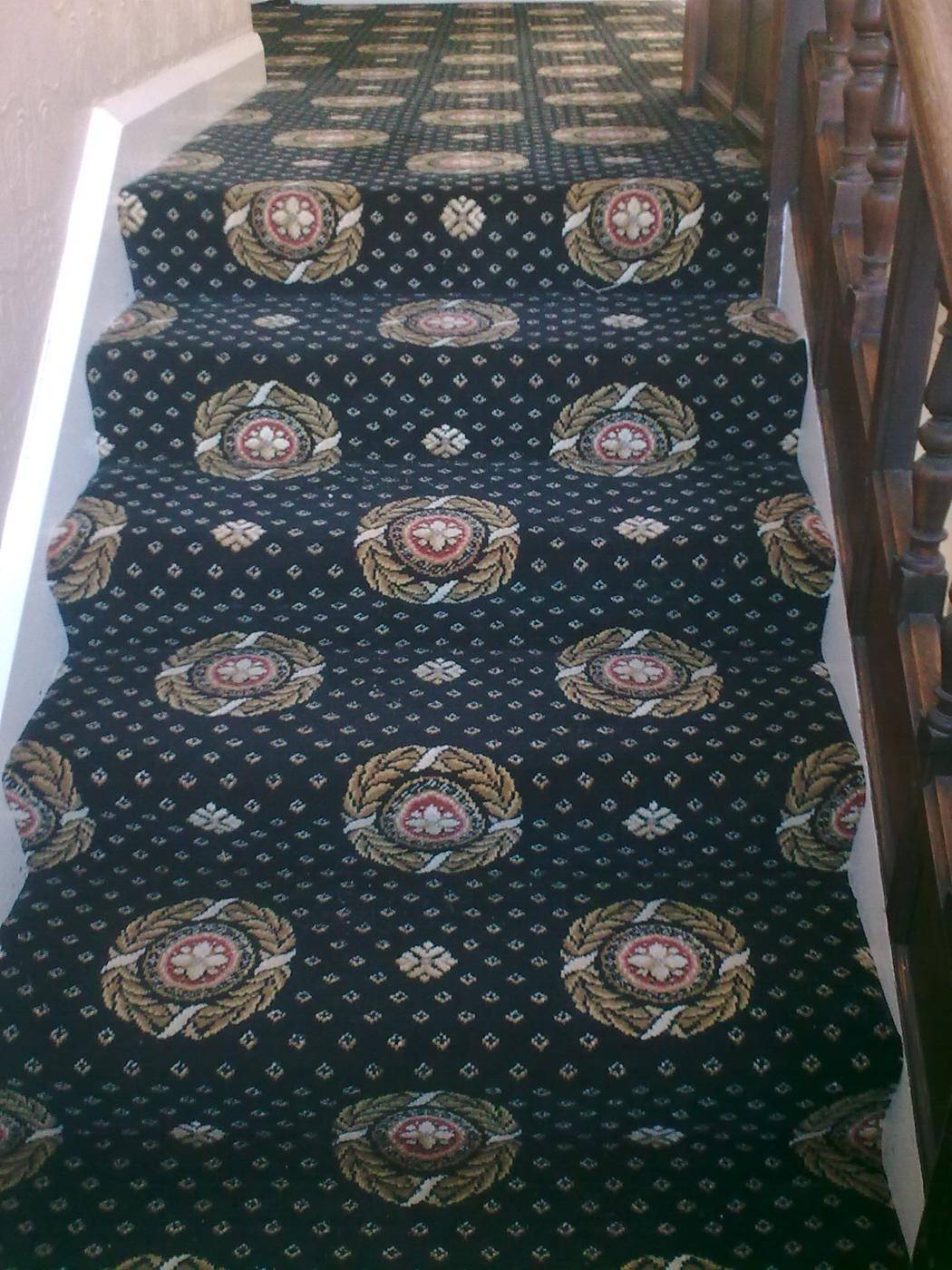
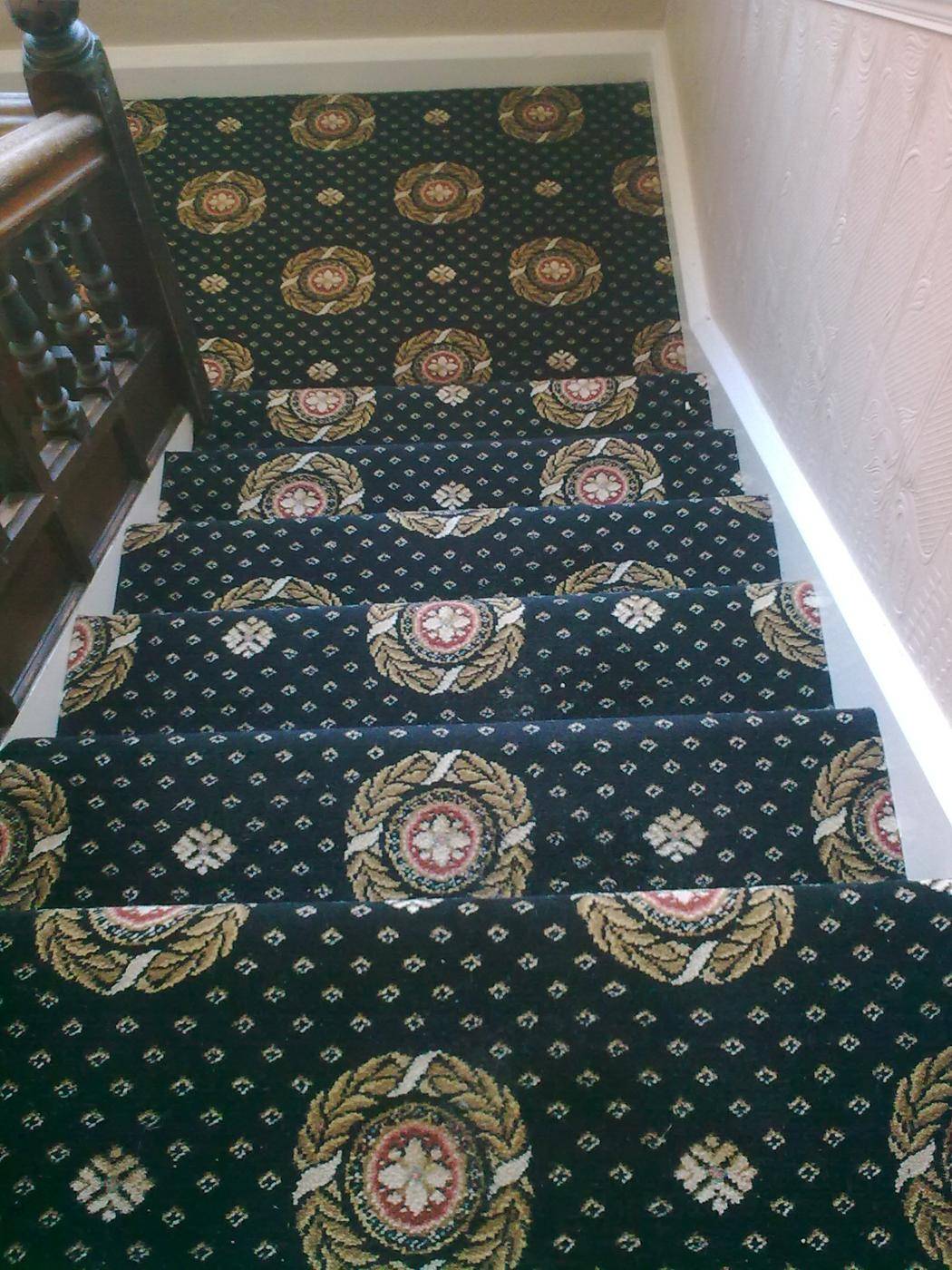
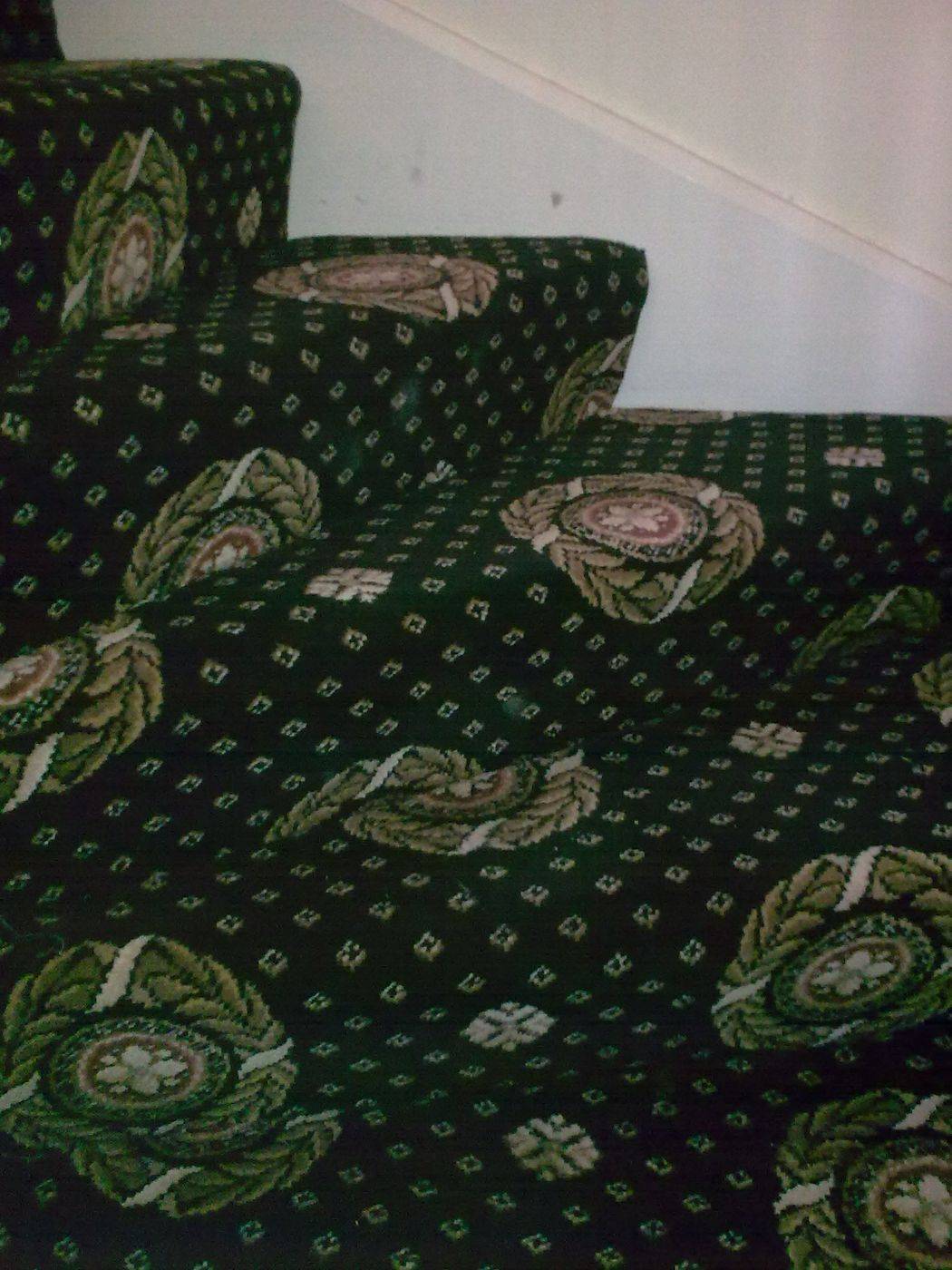
Striped carpets cannot line up on twisting steps because of the different dimension of the differently angled steps. The majority of striped carpets are a one sided design and not symmetrical which effectively means we cannot run one stripe down the centre of the stairs and have the pattern identical at each side.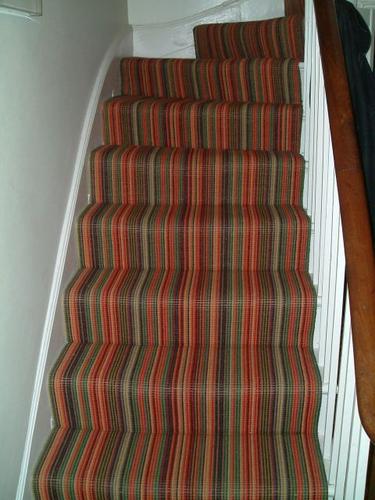
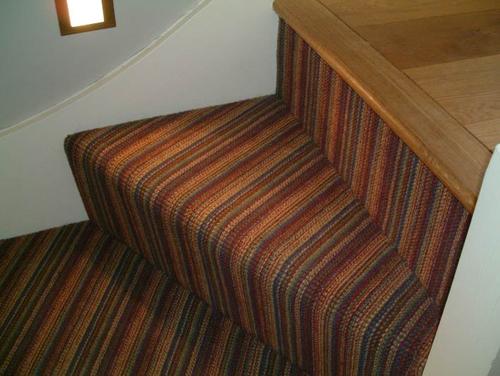
Why is my carpet not exactly the same colour as my sample ?
Samples shown in store are representative of normal production. The flooring ordered for you is likely to be from a different production batch to the one the sample was taken from. Variations between batches are normal and must therefore be expected. We regularly check carpets against the samples to ensure that each batch is a satisfactory match and within the legal tolerance. As well as batch variations, differences may also be due to different lighting or the effect of the surrounding decor in your home, or it may simply be the effect that is common to all carpets which makes them look slightly different according to the angle from which they are viewed.
The texture of the carpet can also be different from batch to batch.
We cannot guarantee an exact colour match with a new piece of flooring from the sample in store or with a previously installed carpet.
Colour matching between different widths of carpet is not guaranteed as most are made on different machines with different yarn batches.
Why is my carpet not the same colour as your web site ?
Images online are often not really a very good representation of the actual colour. We would always recommend that you physically see a sample first in your own home. There can still be variations on colour with different batches but it will give you a closer colour than an online image.
Colour matching between widths of carpet and areas ordered at different times
Most manufacturers of flooring will not guarantee a colour and texture match between the different widths of flooring they produce. They can look very different and yet still be within the manufacturers tolerances. The reason for this is that different width carpets eg 4m wide and 5m wide are produced on different machines. Even if the same dye batch yarn is used they can look a different colour and texture because of the slight differences in the machine tolerances. They can look like 2 different carpets. Unless they are side by side it is not often noticed. Generally it is doorways where they would come together. Different widths are used to help with planning and minimising waste and joints in multiple areas. To keep a colour match throughout a property then you would have to use only one width of carpet from the same roll/batch. This would often lead to joints or excessive waste. Samples shown in store are representative of normal production. The flooring ordered for you is likely to be from a different production batch to the one the sample was taken from. Variations between batches are normal and must therefore be expected. We regularly check carpets against the samples to ensure that each batch is a satisfactory match and within the legal tolerance. As well as batch variations, differences may also be due to different lighting or the effect of the surrounding decor in your home, or it may simply be the effect that is common to all carpets which makes them look slightly different according to the angle from which they are viewed.
The same colour carpet that is ordered at 2 different times will be different in colour and texture as it is from a different dye batch and production run. Again they can look like 2 different carpets. Bear in mind though that even if you ordered 2 carpets at the same time and one is fitted immediately and then another fitted even a short time later they can look very different as one has been subjected to wear from trafficking and UV light causing first fade (a general reduction in colour intensity from when the flooring is first laid). The second carpet when fitted is still very new with no crushed pile and has not been subjected to UV light. Different lighting and decor in different areas can also affect how a colour looks.
Colour Fading - All Floorings fade with normal use, wear and exposure to UV light
Simple answer is Yes it will. All carpets whether wool blend or man made fibre are affected by ultra violet and sunlight. It does not even have to be direct light to affect the colour.
Most products are affected by light over time. This is not a fault in the product.
Manufacturers of flooring will not guarantee the appearance of a product. All products will fade or change colour from new with normal use. A product flattening, fading or changing colour is not a fault. Eg White skirting boards change colour over time. Clothes fade. A bare concrete floor will change colour with normal pedestrian trafficking. It is a normal occurrence.
Fading and colour change is different to wear guarantees or stain guarantees. The product is not wearing out or has a stain, it has just changed colour from normal use. It is regarded as a general reduction in colour intensity from when the flooring is first laid. There are also colour changes where pile gets flattened during use changing how light reflects off the pile and making it look a different colour.
Will I see the joints in my new carpets?
The simple answer is Yes. Some joins can be less visible than others depending on different factors. The plainer, less patterned it is and stronger light source shining across a joint will make it show up more. Often the darker, more patterned and less strong a light source will mean the joint is less visible.
We try wherever possible to avoid joins but sometimes wastage and room sizes mean that it is the most cost effective or only way a room can be planned. Carpets are often in 5 metre wide widths these days and can help avoid joints. We try to plan joins in flooring in less obvious or less trafficked areas wherever possible. We cut two straight edges on carpets and use a heat seam tape to join them together. This is all done by hand. Carpet is a fabric and the pile on one edge of a carpet can be fractionally higher on one piece to another or even from one side to the other on a single piece of carpet. When joined this can make the join more visible. The heat tape used also lifts up the carpet very slightly at the joint. The heat and adhesive applied although, at a recommended temperature, can make the backing of the carpet in this area stiffer and can affect the pile changing the colour slightly. On some carpets it is more visible than others and can appear as a different colour band along the join.
Loop pile carpets do not join very well as we have to cut between the rows of loops on both edges of carpet so that they do not fray. These rows in manufacture are not perfectly straight so even though we join together gaps can be seen. The longer a joint is then the worse this will be. Also there is no pile to brush together to help make a join less visible. A join with a loop pile is always more likely to fray.
Pole Marks - Why has my carpet/vinyl got a line and/or crease marks?
Carpets are rolled around a cardboard tube/pole for transportation. As the edge of the carpet wraps around the tube and is rolled up the cut edge presses into the pile and causes a pressure line approximately 12″- 15” (30cm – 45cm) in from the end (this is the approximate circumference of the tube). This shows as a line almost parallel to a wall in the room. Some customers often think it is a joint in the carpet, but it isn’t. This pile will recover after several weeks of normal hoovering and use as the pile acclimatises, stands back upright and recovers. A similar thing occurs with vinyl flooring but it is just a pressure line on the surface. This also recovers after several weeks.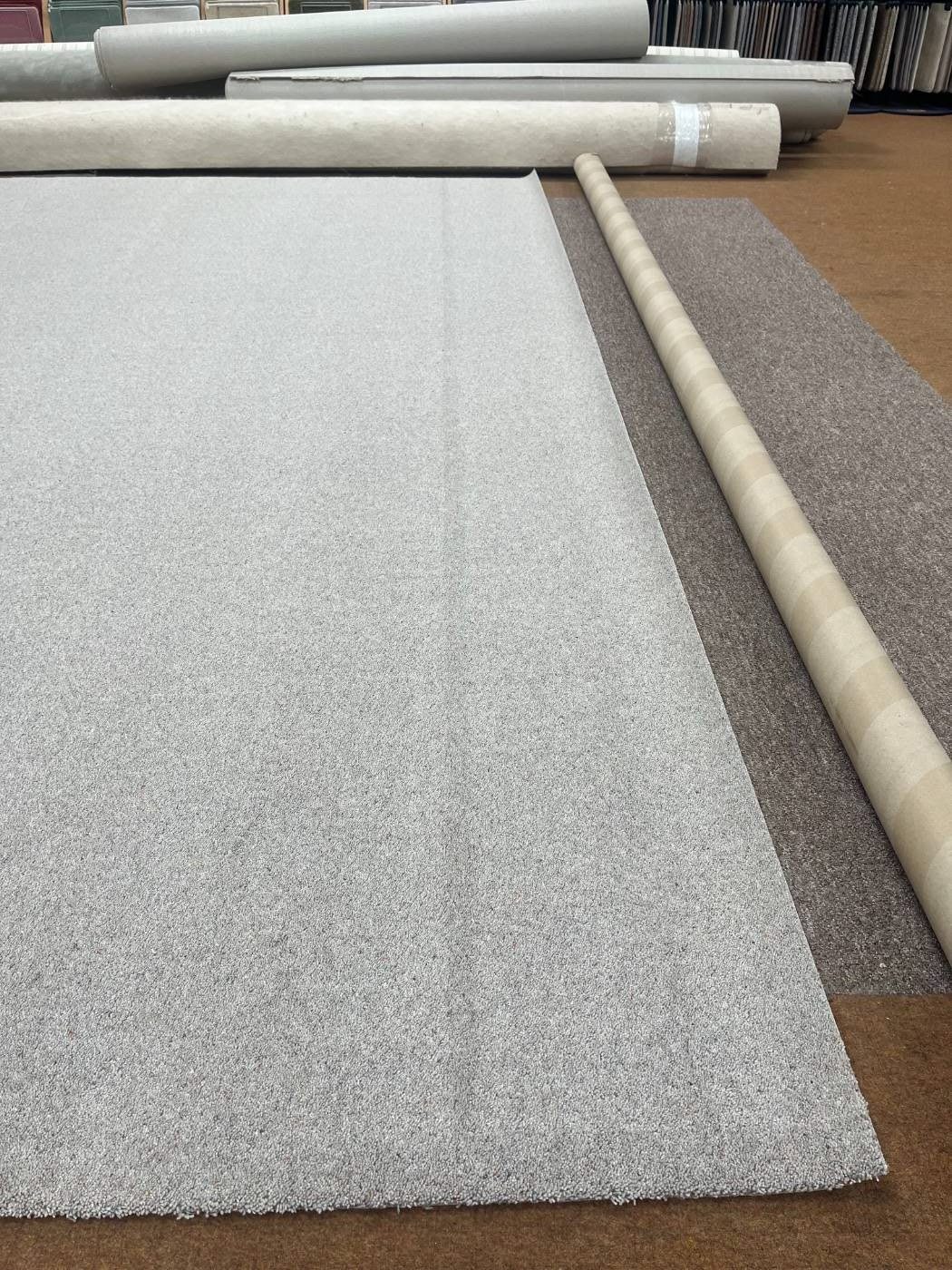
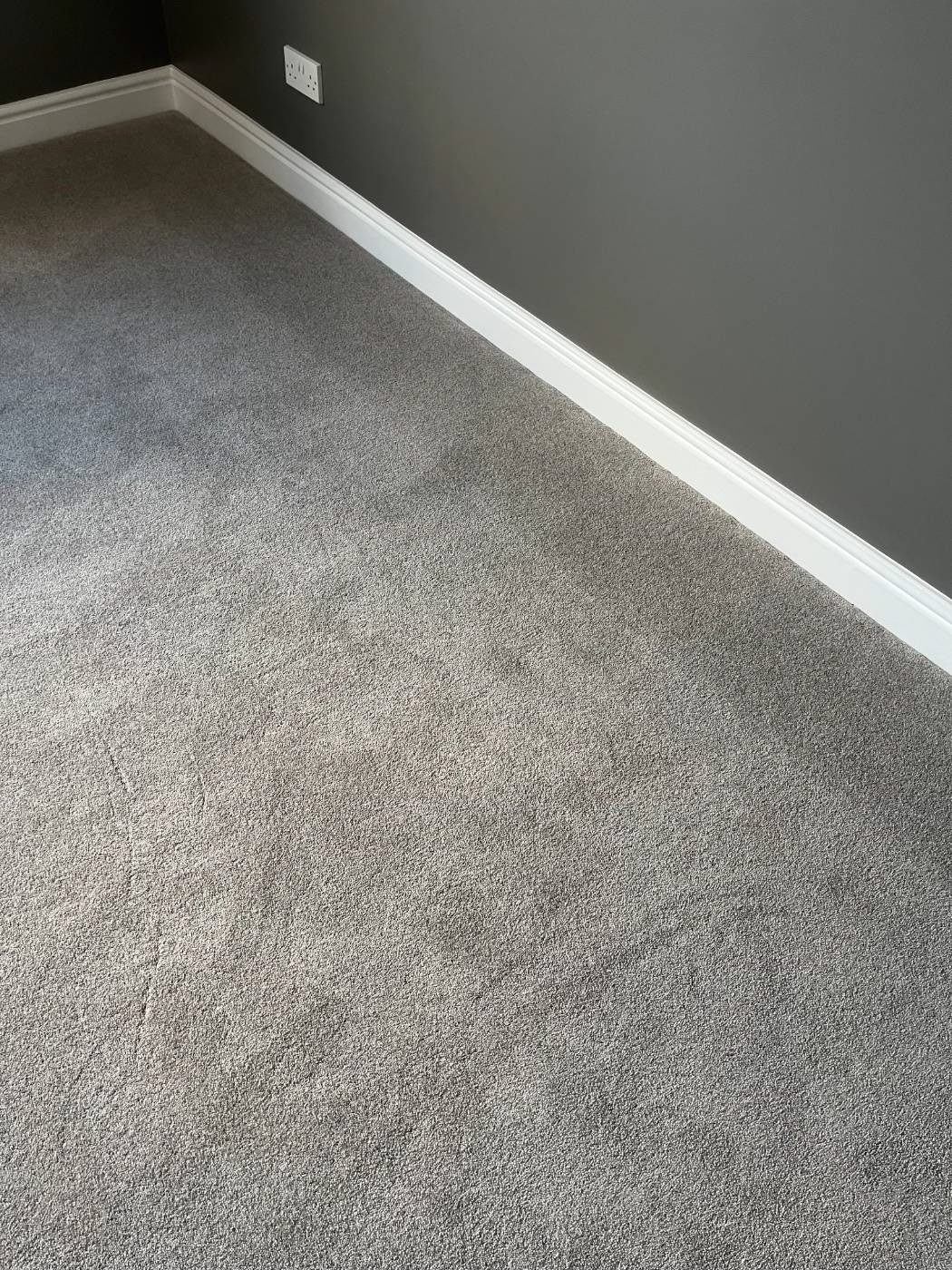
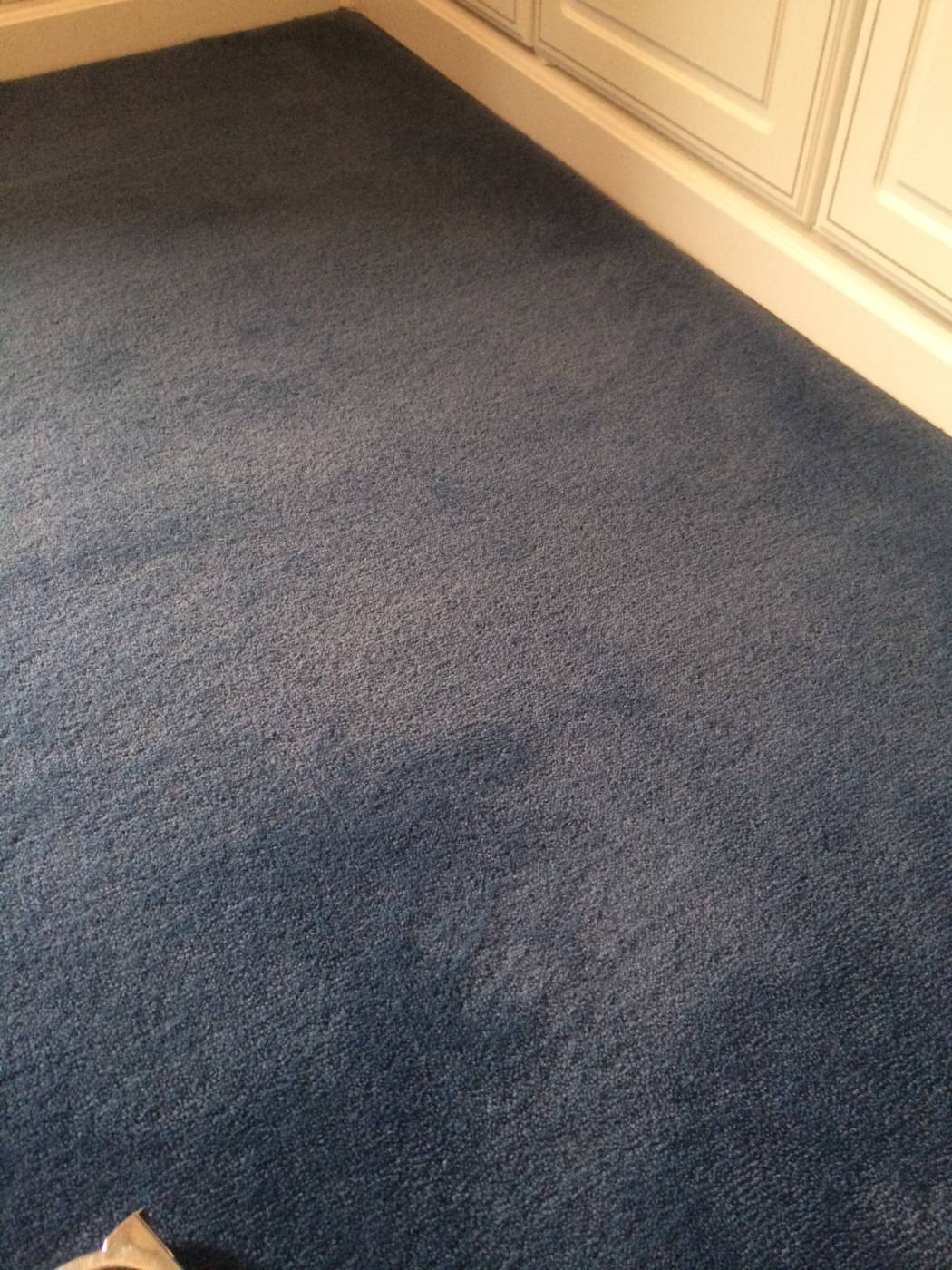
Crease marks are generally caused by delivery of the carpet into the area being fitted and laying out of the flooring in the area being fitted. Carpets and vinyls are often in wide rolls and often have to be bent to get into an area or upstairs. Fitters try to minimise this as much as they can but every property is different and requires different methods of getting into the area being fitted. The flooring supplied can be heavy and is obviously bigger than the room being fitted so it will fold over in some areas as it is pulled and twisted into the correct position for fitting. They do show up more in certain lights but they will also recover after several weeks of normal use.
Why does my carpet have light and dark bands in it? Pressure Marks
Think of a large roll of carpet sat on a shelf or being transported in a vehicle. As it sits there all the weight is sitting on the bottom part of the piece. This crushes the pile slightly. When the carpet is unrolled we get stripes across the width of the carpet of crushed and uncrushed yarn which causes a light and dark effect (like a zebra crossing). It is something we are very familiar with as nearly every carpet will have this to some degree or other but is often a cause for concern when first viewed.
The crushed pile will acclimatise and recover but it can take a few weeks and it will all look the same.
You can see shading and footprints on my carpet, is it faulty?
Footprints and compression marks will show on any carpet where the pile has been disturbed. All carpet pile will bend or brush during use. The newer the carpet the more this can show as any disturbance of new pile will change how it looks in relation to other areas. As the pile bends it reflects light differently to surrounding areas and can look a different colour/texture. It is normal for the random disturbance of the pile during use to give corresponding light and dark patches depending on the angle of the pile in relation to where you are standing. This characteristic is an inherent feature of any type of carpe. Plainer carpets show this affect more but it does happen to patterned carpets as well but it is often not noticed as much.
Why is my carpet shedding?
In production the carpet pile is cropped on the surface or end of the pile. As the pile is a spun yarn with fibres twisted together to form a continuous strand some of these cut ends will release smaller pieces of fibre. All new carpets will shed loose fibres particularly to areas such as walkways, in front of chairs or under tables. Do not be alarmed if your hoover bag fills with fibre. Your carpet is not disintegrating. The shed fibres are expanded by air and therefore appear to be more bulky than they actually are. In fact, fibre loss from the total pile weight is negligible. Shedding has no timetable or cessation. However even a prolonged period of shedding will not affect the performance characteristics of the carpet in any way. This excess fibre is only a small fraction of the total fibre contained within the carpet.
Shedding is normal and will settle down over time.
Can I hoover my new carpet? Cleaning, Maintenance and Loop pile pilling.
We recommend that your carpet be vacuumed on a daily basis from the day of installation.
However, please refer to the manufacturers recommendations on how to properly maintain your carpet. This is generally found on their web pages.
The manufacturer will also often have advice on cleaning and tips for stain removal
The first time you vacuum the carpet please only do a small area at a time and check your hoover bag regularly as there will be a lot of fibre collected initially after fitting. Most new carpets will shed any excess fibre. This is normal but can sometimes be seen as clumps of fibre on the surface. You may have to change the bag or empty the vacuum a few times. Failure to do so may damage your appliance. See FAQ Why is my carpet shedding?
Straight or cut pile carpets – should generally be vacuumed with and upright cleaner with a beater bar as these will remove these fibres more effectively.
Most loop pile carpets – Follow the manufacturers advice on their carpet as some advise a suction only vacuum and some recommend an adjustable brush/ beater bar. The suction hoover should not have any abrasive brushes or pads that rub the pile surface. Some loop pile carpets can have pilling on the surface of the wool loops that will not come off with the suction vacuum. This is excess wool yarn that is shedding and some of it gets caught in the surface of the carpet. Some manufacturers would recommend using a vacuum with adjustable brushes/beater bar to remove this or it may be necessary to crop these at the top of the loops to remove them. (Do not cut the loops). Once these are removed and the carpet stops shedding then you will not have this problem in the future.
Soft deeper pile carpets can be more difficult to hoover with a strong suction cleaner. We recommend a vacuum cleaner that has adjustments to the height and suction to ensure proper airflow over the pile surface during cleaning. Some vacuums will just not move if the suction is too strong or the brushes at the bottom are too low. If possible adjust the suction strength and lift the brushes of the vacuum cleaner or use a less powerful vacuum and use regularly.
My carpet pile has flattened
Every carpet when walked on or has heavy loads on it will show flattening of the fibres. When a carpet is first fitted the pile is brand new so as soon as the carpet is walked on then the pile will show flattening. Flattening is more noticeable in the early months of carpet use because the pile was so new and upright when installed. Carpets will always flatten after use and this will show where the carpet gets used more in some areas than in others. For example doorways in rooms, on steps and stairs, in front of chairs or sofas, in main traffic areas. Softer and longer pile carpets will obviously show this more but it does happen on every carpet. Flattening does not affect the wear of a carpet, only the appearance.
Flattening of carpet fibres is not a defect. It is not a fault of the carpet as it is a localised occurrence on the carpet pile.
Wool carpets are often better at recovering from flattening but they will still flatten.
Man made fibres will go flat but they will not wear out within the life of the carpet.
Why has my carpet got flat patches and TV shuffle?
When a carpets is walked on or has heavy loads on it then flattening will occur. Carpets will always flatten after use and this will show where the carpet gets used more in some areas than in others. Flattening is not wear and is not a defect.
A common distortion of carpet pile is in front of chairs and sofas as we stand up and sit down on them and move our feet whilst sitting. This causes a distortion of the pile in a localised area that shows up more on some carpets and in certain lights. We can often tell where people sit in a room as the pile is disturbed more in front or the seats.
It is not a fault of the carpet as it is a localised occurrence on the carpet pile.
Why does my carpet appear to have shaded areas? Shading, Pile Pressure and Pile Reversal
All cut pile carpets, whatever their method of manufacture, quality or pile content, may develop light and dark patches caused by uneven crushing of the pile. In layman’s terms it means that different areas of the carpet have the pile of the carpet facing in different directions to each other. As they will reflect light differently you can see a colour difference. It is especially noticeable on plainer carpets and even patterns with a more open plainer area between the designs. These may be temporary or permanent. The effect of “shading” or “pile reversal” is a characteristic of all textile materials with a nap or pile and can be influenced by local conditions.
Shading and Pile reversal is a natural phenomenon which cannot be attributed to a fault in the manufacture or materials and will not affect the durability of the carpet.
As carpets are used, hoovered and walked on the pile will distort and flatten, although it does not need to be an area that is walked on to look different. This causes areas that look darker or lighter than areas round them. An area of pile with flatter distorted pile will look a different colour to pile that is standing up straight. This is not a fault in a carpet and does not affect the wear of the carpet.
I have found a different coloured tuft/tufts in my carpet.
A common occurrence in any tufted or woven carpet and can be very easily rectified.
They are known as ‘foreign tufts’ and are generally only reported if the foreign tuft is an obviously different colour to the rest of the carpet ie. A dark tuft on a light coloured carpet.
During manufacture of your carpet it is possible for small pieces of different coloured yarn to get mixed in with the yarn being used. Often it is small pieces of air born yarn from other machines that is drawn into the loom as it operates. These are often additional pieces of yarn within your carpet and can be taken out professionally and re-tufted if necessary. This can be done on site and does not mean uplifting or re-fitting your carpet. Please do not cut or pull these if you find any. Photograph and e-mail to your local store or call us to arrange an inspection.
Indentations from chairs and furniture
Indentations appear as dents or compression marks from whatever has been sitting on the surface of the carpet. and is caused by the concentrated pressure from, castors, chair legs or heavy objects. To reduce the effect of indentations it is advisable to move furniture regularly and make use of aids such as good quality castor cups and chair mats to help minimise the effect of the compression marks.When a carpet is subjected to a point load, such as chair and table legs it is unreasonable not to expect the carpet not to indent.Usually, the longer the load is in place, the longer will be the time for the pile to recover. In the case of very heavy loads in place for a considerable time, the recovery time can be considerable or not achievable.
It is not just the pile of the carpet that will indent. The underlay will also indent and the backing of the carpet may also distort into the indention in the underlay. Some underlays will recover well and some less well depending upon their composition, thickness, density etc. A firmer underlay will generally be better for a carpets pile to recover. Castor cups will spread the load more with a resulting larger area of less indented carpet.
Chairs with castors such as a computer chair that is moved back and forwards at a desk will flatten a carpet more and wear through a lot quicker as it is concentrated wear. A chair mat is recommended to help minimise this.
Where indentations are found on wool blend carpets, then gentle moistening of the effected area by rubbing with an ice cube or alternatively the use of a fine water mist spray can help recovery of the pile. If the backing of the carpet is deformed from the pressure applied to it then the indentation will not come out.
Old Carpets/Flooring Off Cuts and Cardboard Tubes/Poles
It is always advised to have the old carpet removed prior to delivery & installation of the new one this will allow time for any repair or cleaning you may wish to do.
If you are unable to remove we can obtain a quote from the installer to uplift and cut into small pieces so this can be easily transported by you to the local civic skip. Alternatively if you arrange for a skip at your property the fitters will load the old flooring into it for you.
All new offcuts of carpet will be left on site for your use or disposal.
We do offer a service where we can have the offcut trimmed to size and whip the edges to for a rug/door mat – contact your local store for this service
Cardboard tubes – these can be broken up for disposal however we can return these to our store to be reused in our warehouse. Some tubes have been returned and reused that many times we have no alternative but to break them up for disposal.
If I cancel my order will I be charged a cancellation fee?
All orders are cut or quantified to your specific requirements. If your order has already been cut, even if not dispatched, then there will be a charge for re-stocking if that manufacturer has that policy – not all of them will. If the length of a piece is less than the width then the manufacturer will not re-stock and you will have to keep the piece and pay for it. A restocking charge is usually between 30% and 50% of the sale price. All cancellations are discretionary and there may be times when a cancellation is not possible.
Storage Charges
Your goods will be stored in our warehouse free of charge for up to 3 months from the date they arrive into our warehouse.
Should you be unable to accept delivery within the 3 month period a storage charge of £3 per day will be incurred until your order is delivered to your premises. This includes part delivered orders. An invoice for storage costs where appropriate will be raised and must be paid prior to delivery taking place.
Please be aware that storage for this amount of time in our warehouse will increase the likelihood of pressure marks on your carpet. As such they may take longer to settle down. Please see “Why does my carpet have light and dark bands in it? Pressure Marks”
Stair Rods Door bars Maintenance
Instructions on cleaning your Premier Finish Door bars
Brass
Remove spills immediately to limit corrosion with white vinegar. Brass will tarnish over time and we recommend a polishing cloth such as HG copper shine cloth available from most DIY stores. Avoid contact with
floor coverings.
Should corrosion appear, we use this finishing pad, Mirka Total Finishing pad P1500 (grey). Rub the area to remove contamination and buff up with HG copper shine cloth. If in doubt, please email sales@stairrods.co.uk
Satin Brass
Remove spills immediately to limit corrosion with white vinegar. Brass will tarnish over time and we recommend a polishing cloth such as HG copper shine cloth available from most DIY stores. Avoid contact with
floor coverings.
Should corrosion appear, we use this finishing pad, Mirka Total Finishing pad P1500 (grey). Rub the area to remove contamination and buff up with HG copper shine cloth. If in doubt, please email sales@stairrods.co.uk
Antique bronze
Remove spills immediately to limit corrosion with white vinegar. Brass will tarnish over time and we recommend a polishing cloth such as HG copper shine cloth available from most DIY stores. Avoid contact with floor coverings.
Should corrosion appear, we use this finishing pad, Mirka Total Finishing pad P1500 (grey). Rub the area to remove contamination and buff up with HG copper shine cloth. This may go down to the solid brass base however over time the ‘rubbed’ lighter area will tarnish/blend into the antique finish. If in doubt, please email sales@stairrods.co.uk
Antique brass
Remove spills immediately to limit corrosion with white vinegar. Brass will tarnish over time and we recommend a polishing cloth such as HG copper shine cloth available from most DIY stores. Avoid contact with floor coverings.
Should corrosion appear, we use this finishing pad, Mirka Total Finishing pad P1500 (grey). Rub the area to remove contamination and buff up with HG copper shine cloth. This may go down to the solid brass base however over time the ‘rubbed’ lighter area will tarnish/blend into the antique finish. If in doubt, please email sales@stairrods.co.uk
Pewter
Remove spills immediately to limit corrosion with white vinegar. Use a polishing cloth occasionally, such as HG copper shine cloth, available from most DIY stores. Avoid contact with floor coverings.
Chrome, Brushed Chrome, Satin Nickel, Polished Nickel and Black
No maintenance required
Moth Infestations and Treatments
Moths
We have found that moth problems have become more common over the last 20 years. From 2-3 cases per year we now can talk to 2 or 3 cases a month across our stores. It is the moth larvae that eat the wool in a carpet and cause the bald patches. They only infest wool carpets.
Man made carpets are not affected eg Polyproylene, Polyester or Polyamide (nylon).
Generally the bald patches are found in dark areas of the room such as under sofas, furniture etc so it is not noticed very quickly.
Some wool carpets are treated with a moth protection. This means when the larvae comes into contact with or tries to consume the wool then it will die. There are also some wool carpets that are not treated but these will be more susceptible to infestation.
Some of our customers after having a moth infestation have opted for a man made carpet that will not be affected by them.
Pest Control
If you notice small balding patches in the corners and at the edges of your carpets, the chances are that you have an infestation of carpet moths. This is a problem that needs immediate attention because it will continue to get worse. A mated female carpet moth can lay around 200 eggs in her short adult life and an infestation can very quickly get out of hand. Carpet moths are stubborn when it comes to leaving your home!
Use a thorough treatment routine to ensure the carpet moths are thoroughly eradicated.
To Eliminate a Moth Problem
The links below show examples of the types of products that are available in the United Kingdom
https://www.mothkiller.co.uk/carpet-moth-killer-kit—standard-pest-expert-products-3-p.asp
https://www.entopest.co.uk/insect-control/flying-insect-control/moth-control-flying-insect-control-insect-control/carpet-moth-control/
Pocklington Carpets have no affiliation with these sites or products. They are just a couple of the many companies offering solutions.
We encourage you to do your own research and check any safety information provided by the manufacturer to see whether the product will be suitable for your requirements.
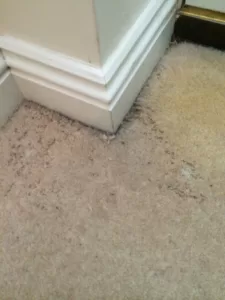
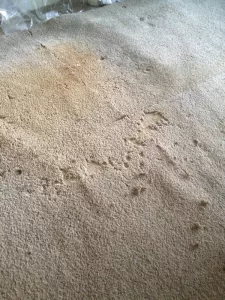
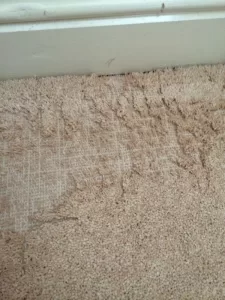
Identifying Tapestry Moths (Carpet Moth)
The Tapestry Moth or Carpet Moth (Trichophaga tapetzella) is found worldwide. In common with clothes moths, the carpet moth is very small. The adult case-bearing carpet moth is approximately 5mm in length. Their wingspan is typically 14-18 mm and has yellowish-brown forewings with three darker dots on each wing. Their hind wings are pale grey and are fringed with hair.
Case-bearing carpet moth eggs are whitish in colour. Their larvae are more distinctive as they are opaque white with brown heads; however, the grub weaves a silken case around itself as it grows, which seals when it is large enough so the grub can pupate. A case containing a pupating grub looks like a grain of rice and is likely to be found in dark corners or under furniture.
The moth flies from April to October depending on the location and has very distinctive markings assisting with identification (see picture right). The larvae feed on animal skin, bird nests, fur, clothing, carpets and upholstery made of natural fibres or animal skin. Carpet moths can complete a number of lifecycles within a year and are more like webbing clothes moths in that they spin webbing in areas where they like to reside. You may see these silken cases or threads, either during their life as larvae or after pupation. Their speed of development depends entirely upon local temperature, humidity and food supplies and can be as fast as 8 weeks from egg to adult, resulting in several generations during the summer, but the last generation of larvae will carry on as larvae through the winter (and eating your carpet) while waiting for the warmer spring temperatures to pupate and re-start the adult cycle. It is not uncommon to find larvae the same colour as your carpet fibres having eaten the dyes in the carpet pile. They will look for undisturbed, darker areas to lay their eggs – hence being more likely found under sofas and other furniture, behind curtains and along skirting boards.
Please note that Clothes Moth larvae are just as likely to eat the wool in carpets – if your carpet moth damage issue looks like it is from a different moth to the Tapestry or Carpet Moth, it may well be Webbing Clothes Moths. Regardless of the type of moth invading your home. You may wish to consider protecting your clothes in wardrobes, cupboards and drawers if you have experienced moths in your home in case they have reached other rooms in the house.
The Life Cycle of a Carpet Moth
The carpet moth has a very similar life cycle to a clothes moth. The adults do not live long and the mated adult female lays hundreds of eggs in her short life time. The eggs will be laid in the quieter, darker and undisturbed areas of carpets and rugs and lay dormant for approximately 4 to 10 days before hatching. The larvae can live for up to 2 years which accounts for continued damage as they eat through the winter months, but in warmer periods they will pupate within 2 months of hatching, resulting in a number of cycles through the Spring to Autumn months. The pupation stage will last up to 2 weeks before the adults emerge. The adults are relatively harmless and only live 2-3 months, but the issue and risk to property is clearly the risk of further egg laying and the infestation getting out of land, hence the need to deal with both adult and larvae stages of the carpet moth lifecycle in treatment routines.
Guarantees and Warranties
Fitters
A guarantee for 12 months from the installation date for the carpet to be stretched if required. Carpet comes from a cold warehouse into a warmer domestic environment and can expand as it acclimatises. Occasionally the carpet requires another stretch.
Manufacturers Stain Warranties
These can be specific for each manufacturer but the general guidelines are
*Your carpet is guaranteed against common household stains. In the unlikely event of a stain that cannot be removed by a professional cleaner, the manufacturer will guarantee to replace any carpet protected by this guarantee free of charge.
*The guarantee covers the purchaser’s normal indoor use of carpets installed in a single family, domestic residence.
*Applicable to staining only on carpets purchased, fitted, and used in the UK
SOME OF THE THINGS YOU MAY HAVE TO DO TO VALIDATE THE GUARANTEE/WARRANTY
*Register online with the manufacturer
*Keep your receipt from the store you purchased from
*Have the carpet installed by a qualified fitter in accordance with BS5325
*Keep a piece of leftover carpet. In the unlikely event of staining, this will be helpful for testing by our technical team
*Clean and vacuum regularly
*Have your carpet professionally cleaned once every two years and keep receipts for proof of this.
* Some substances are not guaranteed and there may be a list things that are included or not included in the warranty.
Generally normal household food and drink stains only. Human/Pets vomit or bodily fluids, some dyes and chemicals will not be included.
PLEASE CHECK WITH THE INDIVIDUAL MANUFACTURER AS THE TERMS CAN VARY
Wear Guarantee
The wear guarantees offered by manufacturers are only based on the pile of the carpet not wearing down to the backing of the carpet in normal domestic use for the number of years stated on the guarantee of each product.
The manufacturers do not guarantee appearance such as Pile flattening or distortion through use, staining with items not in the list of cleanable substances, tearing, stretching etc.
A guide to a general Guarantee from manufacturers – Check each guarantee as it can vary between manufacturers.
The manufacturer will generally warrant to replace any carpet covered by their guarantee which fails to meet the wear characteristics outlined in their warranty. This may be on a reducing scale Guarantee/Warranty. See further down.
The word “Wear’ in relation to the terms of their warranty is the wearing of the pile surface down to the backing under normal conditions of domestic use; where an area of the backing of approximately 10cms diameter is visible.
General conditions;
1. The wear warranty relates to normal indoor use installed in a single family domestic residence.
2. All carpet covered by the warranty must be installed in a single family domestic residence.
3. The carpet must be regularly maintained with regular vacuum cleaning (at least weekly) and must be professionally cleaned
at least once every 2 years from date of purchase and recorded evidence kept.
4. The warranty is specific to the original user and is not transferable.
5. The warranty is specific to the wearing out of the pile surface through to the backing. Whilst construction of carpets are suitable for a wide variety of applications manufacturers cannot warrant against change of surface appearance whilst in general use.
SOME OF THE THINGS YOU MAY HAVE TO DO TO VALIDATE THE GUARANTEE/WARRANTY
1. Register online with the manufacturer
2. Keep your receipt from the store you purchased from
3. Have the carpet installed by a qualified fitter in accordance with BS5325
4. Maintain the carpet in accordance with the general conditions. Clean and vacuum regularly
5. Ideally retain an unused offcut (whilst this is not a condition of the warranty, it will help determine if any manufacturing
defect was present).
Reducing Scale Guarantees
A “customer guarantee on a reducing scale” refers to a guarantee or warranty where the level of coverage or benefit diminishes over time, offering a higher level of protection initially, but less as time passes. If you have had the benefit/use of a product for whatever period of time then this will be taken into account with your warranty.
Need help or want to know more?
Customer Service tadcaster@pocklington-carpets.com